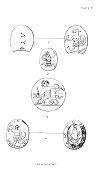
The Gnostics and Their Remains, by Charles William King, [1887], at sacred-texts.com

The Gnostics and Their Remains, by Charles William King, [1887], at sacred-texts.com

Click to enlarge
Plate B.
1. Abraxas, represented here with the head of an ass, and thereby identified with Typhon, a singular perversion of ancient ideas. This gem is valuable as distinctly declaring its purpose by the legend on the
reverse, Φ·?YΛ(φύλασσε), "Defend me," addressed to the Power depicted upon it; and thus putting out of doubt the destruction of all the other specimens of its class.
2. Abraxas, of neat work and early date, not later than the fourth century.
3. The Giant Typhoeus defying Jove: his serpent-legs denote that he is the son of Mother Earth. This beautiful intaglio, which is of Italo-Greek workmanship, and found at Cumæ, is introduced here merely to show the source whence the sectaries of the Decline borrowed the idea of similar combinations of discordant natures. (Burnt sard: New York.)
4. Abraxas, with whip and shield, combining his influence with Horus, seated on the lotus, the regular personification of the Vernal Sun. The meaning of the type is set forth in the legend, which is the Greek transliteration of the Hebrew Shemesh Ilam, "Sun of the Universe." The union of the two types indicates that Abraxas is here to be understood in his original sense, the simple personification of the Solar Power.